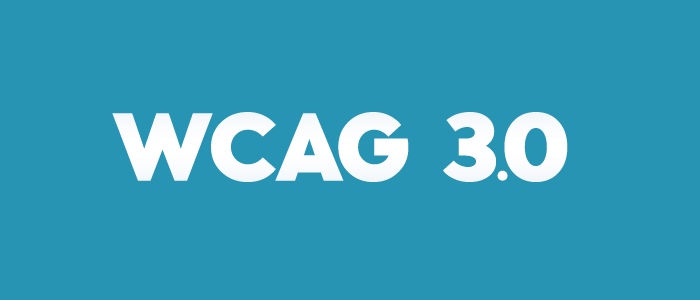Today marks a milestone in digital accessibility, where the W3C announces the first public working draft of the W3C Accessibility Guidelines (WCAG) 3.0. WCAG is the most important standard in digital accessibility, so a new version is certain to shake things up. This article is the first in a series of two. In this first article, we take a closer look at what the W3C is proposing to change in WCAG 3.0. In part 2, we will give some of the background on WCAG, and how this new version came to be.
WCAG 3.0’s proposed structure
WCAG 3.0 is designed to be easier to learn, and for its results to better reflect the experience of people with disabilities on the web. This has resulted in a structure for WCAG 3 that is substantially different from the WCAG 2.x series. Let’s look at some of these new structures.
Outcomes
Perhaps the most notable proposed change for WCAG 3.0 is the change from using success criteria to outcomes. Where success criteria were true-or-false statements about the content of a web page, an outcome in WCAG 3.0 is a statement about the need of certain users for specific types of content. Outcomes are not true-or-false statements, rather they are answered with a rating from 0 (very poor) to 4 (excellent). These scores can then be combined with the scores of other outcomes to determine the level of accessibility. This allows for a website to have some issues while still meeting a level of conformance.
Critical errors
In addition to a rating, each outcome defines what is considered a critical error for that outcome. For example, a critical error for text alternatives of images are images without a text alternative which prevent a user from completing a task. A website can have a small number of accessibility errors, but if it has any critical errors it does not conform to WCAG 3.0 at any level.
Bronze, Silver, Gold
Instead of using levels A, AA, and AAA, WCAG 3.0 has the conformance levels bronze, silver, and gold. In the first draft of WCAG 3.0, most of the focus has gone into the bronze level. This level will be roughly equivalent to level A + AA of WCAG 2.1.
There is not much in the first draft of WCAG 3.0 on what the silver and gold levels will be like. What is clear is that the W3C is planning to introduce different types of testing for these levels then there will be for the bronze level. The bronze level will consist of “atomic” tests, which is the type of “element by element testing” that is part of WCAG 2.x as well. For silver and gold levels, the W3C is looking into using other types of testing, such as usability testing, testing with assistive technologies, and cognitive walkthroughs. We should get more details about silver and gold levels in a later draft of WCAG 3.0.
Comparison to WCAG 2
A good starting point to understand WCAG 3.0 is to compare it to WCAG 2.x. The following table shows concepts from WCAG 2.x, and what their equivalents are in this first draft of WCAG 3.0.
| WCAG 2.x | WCAG 3.0 |
| Principles | Removed |
| Guidelines | Guidelines |
| Success criteria | Outcomes |
| Techniques | Methods |
| Non-interference requirements | Critical errors |
| Level A, AA, AAA | Bronze, Silver, Gold |
Adoption
There is a lot of work left for WCAG 3.0, so don’t expect to be using it any time soon. While experimentation and feedback are always appreciated, it is not recommended for anyone to start using WCAG 3.0 in earnest until it is published as a W3C recommendation. The earliest this is likely to happen is in 2023.
You will likely not see WCAG 3.0 testing in tools or audits until that time. It is also far too early for there to be any kind of timeline for adopting WCAG 3.0 in laws or legislation. This is not likely to happen until there is a clear end of the line.
Providing feedback
If you are interested in helping out, a good way to get started is to provide public feedback. The WCAG 3.0 first draft has a lot of editor notes to help reviewers understand specifically what types of questions the W3C is looking for feedback on. To comment, file an issue in the W3C silver GitHub repository. It is free to create a GitHub account to file issues. If filing issues in GitHub is not feasible, you can email to public-agwg-comments@w3.org.
Somewhat unique to the development of WCAG 3.0 is that participation is open to anyone. If you do not work for a W3C member, you can still participate if you join the Silver community group. All you need is an account on the W3C website. There is a lot of work left to be done, so if you can spare a few hours a week, your participation will be appreciated.
First impressions
WCAG 3.0 is a highly ambitious project, with lofty goals to significantly improve and expand on WCAG 2.x in a dozen different areas. Simultaneously, WCAG 3.0 is striving to keep up, if not improve on the qualities of WCAG 2.x that allowed it to be adopted by regulations around the globe.
Our first impressions are cautiously optimistic. The research that has preceded WCAG 3.0 was thorough, and the data-driven approach that the chairs and editors for WCAG 3.0 have taken is encouraging. While many details have yet to be worked out, and many things proposed today will likely be revised along the way, there is a very capable team working on this new version of WCAG, a team that we at Deque are excited to participate in.
Check out part 2 where we’ll take a closer look at how WCAG 3.0 came about, what its stated goals are, and why WCAG 3.0 no longer includes “web content” in the name.

